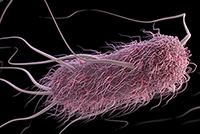FoodNet 2016 Preliminary Data
Documenting trends in foodborne illness—identifying which illnesses are decreasing and which are increasing—is essential to the overall goal of reducing foodborne illness. Each year, FoodNet reports on changes in the number of people in the United States sickened with infections from pathogens transmitted commonly through food. These pathogens have been detected by laboratory tests, including culture and culture-independent diagnostic tests (CIDTs).
This year’s report summarizes 2016 preliminary surveillance data and describes trends since 2013 for infections monitored by FoodNet—Campylobacter, Cryptosporidium, Cyclospora, Listeria, Salmonella, Shiga toxin-producing Escherichia coli (STEC), Shigella, Vibrio, Yersinia—as well as cases of hemolytic uremic syndrome (HUS) for 2015, the most recent year for which data are available.
Key Findings
- View Tables & Figures
- In 2016, FoodNet received reports of 24,029 illnesses, 5,512 hospitalizations, and 98 deaths due to infections that were confirmed or CIDT-positive.
- The incidence of confirmed or CIDT-positive infections per 100,000 was highest for Campylobacter and Salmonella, which is consistent with previous years.
- The number of CIDT-positive reports is increasing. The number of Campylobacter, Salmonella, Shigella, Vibrio, and Yersinia infections diagnosed by CIDT alone increased 114% in 2016 compared with the 2013–2015 average.
- Although CIDTs can provide timely information for clinical management of foodborne infections and are easier for laboratories to do, increasing use of CIDTs affects interpretation of public health surveillance data and our ability to monitor progress toward achieving prevention goals. It is difficult to interpret whether these are true changes in incidence or whether the change is in part or completely due to changes in diagnostic testing practices and procedures.
- Trends for some pathogens may be more affected than others by changes in use of CIDTs. Listeria infections, for which CIDTs have not previously been available, and cases of HUS, which do not rely on CIDT, did not change significantly in 2016 compared with the previous three years.
- Recent changes in diagnostic practices also challenge our ability to find outbreaks and monitor disease trends. Some information about the bacteria causing infections, such as subtype and antimicrobial susceptibility, can be obtained only if a CIDT-positive specimen is also cultured. FoodNet is gathering additional information to better understand the effect of CIDT on surveillance.
Questions & Answers About Food Safety
Suggested citation: Centers for Disease Control and Prevention (CDC). Incidence and Trends of Infection with Pathogens Transmitted Commonly Through Food and the Effect of Increasing Use of Culture-Independent Diagnostic Tests on Surveillance—Foodborne Diseases Active Surveillance Network, 10 U.S. Sites, 2013–2016. MMWR Morb Mortal Wkly Rep. 2017 April 20.




